AUDI TT COUPE 2016 Owners Manual
Manufacturer: AUDI, Model Year: 2016, Model line: TT COUPE, Model: AUDI TT COUPE 2016Pages: 322, PDF Size: 52.86 MB
Page 191 of 322
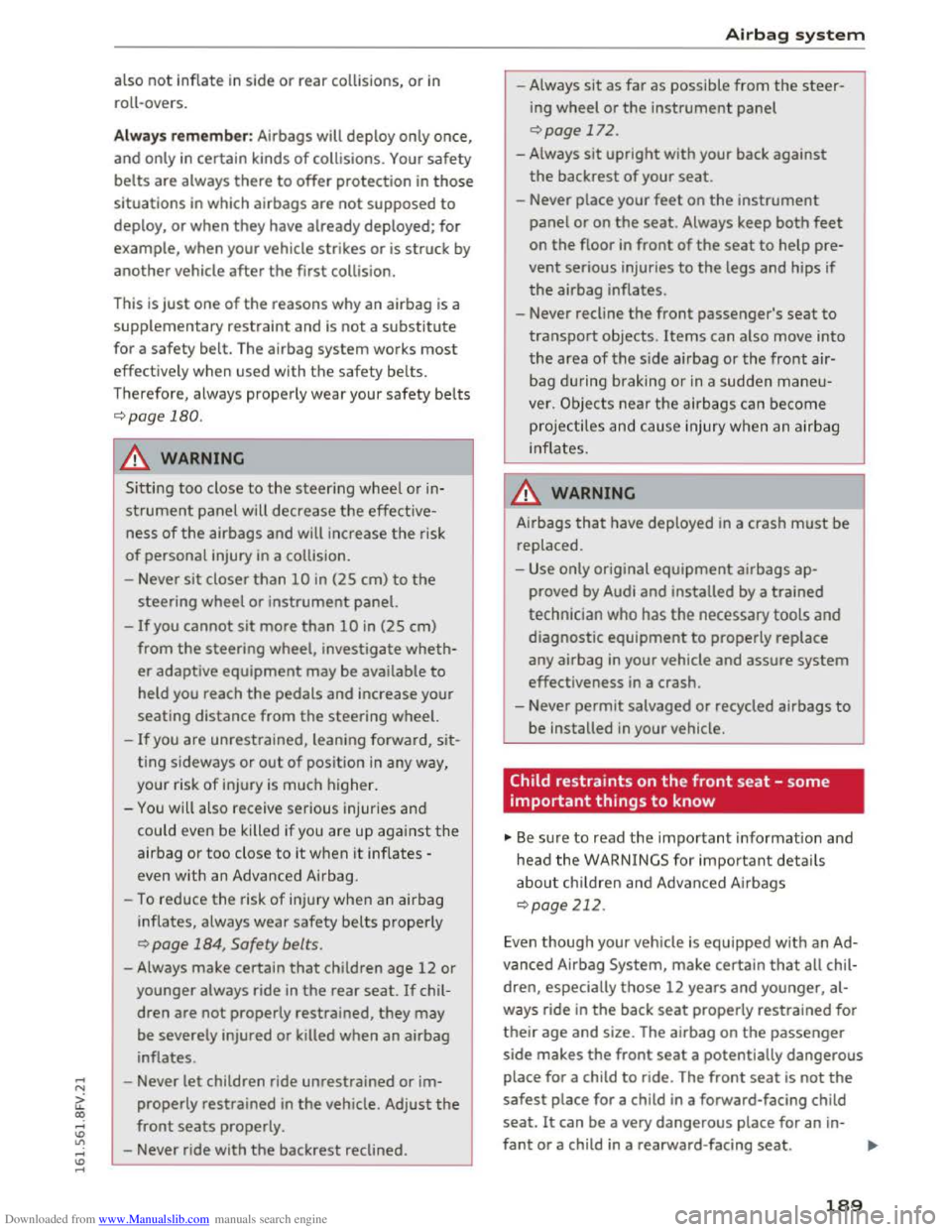
Downloaded from www.Manualslib.com manuals search engine ...... N
G'. CX)
..... ID IJ' ..... ID .....
also not inflate in side or rear collisions, or in
roll-overs.
Always rememb er: Airbags will deploy only once,
and only
in certain kinds of collisions . Your safety
belts are always there to offer protection in those
situations in which airbags are not supposed to
deploy, or when they have already deployed; for
example, when your vehicle strikes or is struck by
another vehicle after the first collision.
This
is just one of the reasons why an airbag is a
supplementary restraint and is not a substitute
for a safety belt. The airbag system works most
effectively when used with the safety belts.
Therefore, always properly wear your safety belts
r:::;.page 180.
A WARNING
-
Sitting too close to the steering wheel or in-
strument panel will decrease the effective
ness of the airbags and will increase the risk
of personal injury in a collision.
- Never
sit closer than 10 in (25 cm) to the
steering wheel or instrument panel.
-
If you cannot sit more than 10 in (25 cm)
from the steering wheel, investigate wheth
er adaptive equipment may be available to
held you reach the pedals and increase your
seating distance from the steering wheel.
-If you are unrestrained, leaning forward, sit
t ing sideways
or out of position in any way,
your risk
of injury is much higher.
-
You will also receive serious injuries and
could even be killed if you are up against the
airbag or too close to it when it inf lates -
even with an Advanced Airbag.
- To reduce
the risk of injury when an airbag
inflates, always
wear safety belts properly
Q page 184, Safety belts.
-Always make certain that children age 12 or
younger always ride in the rear seat. If chil
dren are not properly restrained, they may
be severely injured or killed when an airbag
inflates.
- Never
let children ride unrestrained or im
properly
restrained in the vehicle. Adjust the
front seats properly .
- Never ride with
the backrest reclined .
Airbag system
-Always sit as far as possible from the steer
ing wheel or the instrument panel
r:=:>page 172.
-Always sit upright with your back against
the backrest of your seat.
- Never place your feet on the instrument
panel or on the seat. Always keep both feet
on the floor in front of the seat to help pre
vent serious injuries to the legs and hips if
the airbag inflates.
- Never recline
the front passenger's seat to
transport objects. Items can also move into
the area of the side airbag or the front air
bag during braking
or in a sudden maneu
ver. Objects near the airbags can become
projectiles and cause injury when an airbag
inflates.
A WARNING ___,j
Airbags that have deployed in a crash must be
replaced.
-
Use only original equipment airbags ap
proved by Audi and installed by a trained
technician who has the necessary tools and
diagnostic equipment to properly replace
any
airbag in your vehicle and assure system
effectiveness in a crash.
- Never
permit salvaged or recycled airbags to
be installed in your vehicle.
Child restraints on the front seat -some
important things to know
"' Be sure to read the important information and
head the WARNINGS for important details
about children and Advanced Airbags
r:::;.page 212.
Even though your vehicle is equipped with an Ad
vanced Airbag
System, make certain that all chil
dren, especially those 12 years and younger, al
ways ride
in the back seat properly restrained for
their age and size. The airbag on the passenger
side makes the front seat a potentially dangerous
place for a child to ride . The front seat is not the
safest place for a child in a forward-facing child
seat. It can be a very dangerous place for an in-
fant or a child in a rearward -facing seat. ..,.
189
Page 192 of 322
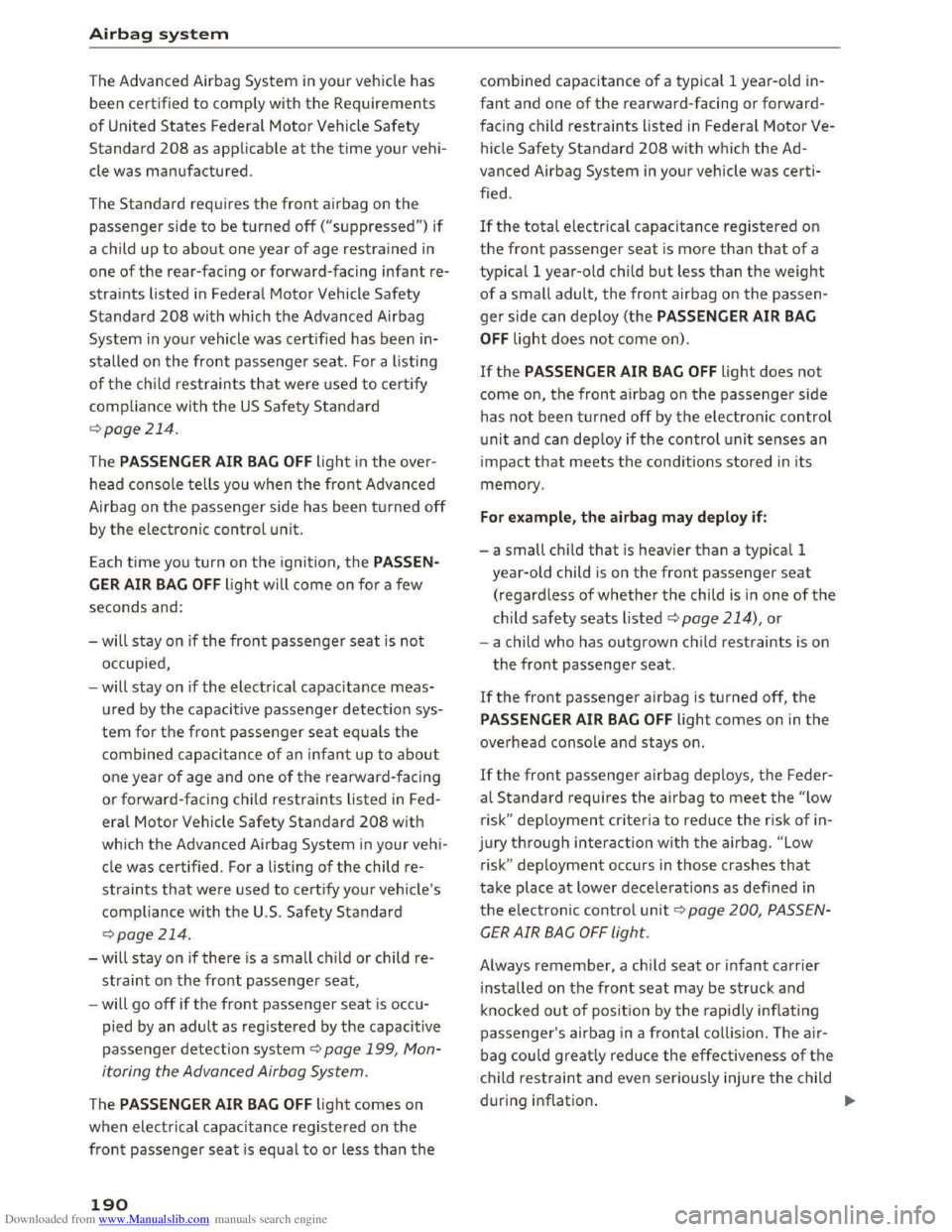
Downloaded from www.Manualslib.com manuals search engine Airbag system
The Advanced Airbag System in your vehicle has
been certified to comply with the Requirements
of United States Federal Motor Vehicle Safety
Standard 208 as applicable at the time your vehi
cle
was manufactured.
The
Standard requires the front airbag on the
passenger side to be turned off ("suppressed") if
a child up
to about one year of age restrained in
one of the rear-facing or forward-facing infant re
straints listed in Federal Motor Vehicle Safety
Standard 208 with which the Advanced Airbag
System in your vehicle was certified has been in
stalled on the front passenger seat. For a listing
of the child restraints that were used to certify
compliance with the US Safety Standard
<=!>page 214.
The PA SSENGER AIR BAG OFF light in the over
head console tells you when the front Advan ced
Airbag on the passenger side has been turned off
by the electronic control unit.
E ach ti
me you turn on the igni tion, the PASSEN
GER
AIR BAG OFF l ight will come on fo r a few
seconds and:
- will stay on if the front passenger seat is not
occupied,
- will
stay on if the electrical capacitance meas
u red by the capacitive passenger detection sys
tem fo r th e fron t passenger seat equals the
combined capaci tance of an infant up to about
one year of age and one of the rearward-facing
or forward-facing child restraints listed in Fed
eral Motor Vehicle Safety Standard 208 with
which the Advanced Airbag System in your vehi
cle
was certifi ed. For a listing of the child re
straints that were used to certify your vehicle's
compliance with the U .S . Safety Standard
<=!>page 214.
- will stay on if there is a small ch ild or child re
straint on the front passenger seat,
- will go off if the front passenger seat is occu
pied by
an adult as registered by the capacitive
passenger detection system<=!> page 199, Mon
itoring the Advanced Airbag System.
The PASSENGER AIR BAG OFF light comes on
when electrical capacitance registered on the
front passenger seat is equal to or less than the
190
combined capacitance of a typical 1 year-old in
fant and one of the rearward-facing or forward
facing child restraints listed in Federal Motor Ve
hicle
Safety Standard 208 w ith which the Ad
vanced Airbag
System in your vehicle was certi
fied .
If the total electrica l capacitance registered on
the front passenger seat is more than that of a
typi ca l 1 year-old child but less than the weight
of a small adult, the front airbag on the passen
ger side can deploy (the PASSENGER AIR BAG
OFF light does not come on).
If the PAS SENGER AIR BAG OFF light does not
come on, the front airbag on the passenger side
has not been turned off by the electronic con trol
u
nit and can depl oy if the control unit senses an
impact that meets the conditions stored in its
memory .
For example, the airbag may deploy if:
- a small child that is heavier than a typical 1
year-old child is
on the front passenger seat
(regardless of whether the child is in one of the
child safety seats l isted<=:> page 214), or
- a child who has outgrown child restraints is on
the front passenger seat.
If the front passenger airbag is turned off, the
PASSENGER AIR BAG OFF ligh t comes on in the
overhead console and stays on.
If the front passenger airbag deploys, the Feder
al Standard requires the airbag to meet the "low
risk"
deployment criteria to reduce the r isk of in
jury through interaction w ith the airbag. "Low
risk "
deployment occurs in those crashes that
take place at lower decelerations as defined in
the electronic co ntrol unit<=!> page 200, PASSEN
G ER AIR BAG OFF light.
Always remember, a child seat or infant carrier
installed on the front seat may be struck and
k nocked out of positio n by the rapidly inflating
passenger's airbag i n a frontal collision. The a ir
bag cou ld greatly reduce the effectiveness of the
child restraint and even seriously injure the child
d uring inflation .
Page 193 of 322

Downloaded from www.Manualslib.com manuals search engine For this reason, and because the back seat is the
safest place for children -when properly restrain
ed according
to their age and size -we strongly
recommend that children always sit in the back
seat Q page 212, Child safety.
_&WARNING
A child in a rearward-fac ing child seat instal
led on
the front passenger seat will be seri
ously injured
and can be killed if the front air
bag inflates -even with
an Advanced Airbag
System.
-The inflating airbag will hit the child seat or
infant carrier with great force and will
smash the child seat and child against the
backrest, center armrest, door or roof.
- Always
install rear-facing child seats on the
rear seat.
-If you must install a rearward facing child
seat on the front passenger seat because of
exceptional circumstances and the PASSEN·
GER AIR BAG OFF light does not come on
and stay on, immediately install the rear
facing child
seat in a rear seating position
and have
the airbag system inspected by
your Audi dealer.
- Forward-facing child
seats installed on the
front passenger's seat may interfere with
the deployment of the airbag and cause se·
rious personal injury to the child.
A WARNING
If, in exceptional circumstances, you must in
stall a forward-facing child restraint on the
front passenger's seat:
-Always make sure the forward-facing seat
has been designed and certified by its man
ufacturer for use on a front seat with a pas
senger front and side airbag.
- Never
put the forward-facing child restraint
up against or very near the instrument pan
el.
-Always move the passenger seat into its
rearmost position in the seat's fore and aft
adjustment range, as far away from the air
bag as possible
before installing the for-
Airbag system
ward-facing child restraint. The backrest
must be adjusted to an upright position.
- Make
sure that the PASSEN GER AIR BAG
OFF light comes on and stays on all the time
whenever the ignition is switched on.
A WARNING
To reduce the risk of serious injury, make sure
that the PASSENGER AIR BAG OFF light will
be displayed
whenever a child restraint is in
stalled on the front passenger seat and the
ignition is switched on.
-
If the PAS SENGER AIR BAG OFF light does
not stay on, perform the checks described
~page 199, Monitoring the Advanced Air·
bag System.
-Take the child restraint off the front passen·
ger seat and install it properly at one of the
rear seat positions if the PASSENGER AIR
BAG OFF light does not stay on.
- Have
the airbag system inspected by your
Audi dealer immediately.
- Always carefully follow
instructions from
child restraint manufacturers when instal
ling child restraints.
A WARNING
If, in exceptional circumstances, you must in
stall a forward or rearward-facing child re
straint on the front passenger's seat:
-Improper installation of child restraints can
reduce their effectiveness or even prevent
them from provid ing any protection.
-An improperly installed child restraint can
interfere with the airbag as it deploys and
seriously injure
or even kill the child -even
with an Advanced Airbag System.
-Always carefully follow the manufacturer's
instructions provided with the child seat or
carrier.
-Always make sure that there is nothing on
the front passenger seat that will cause the
capacitive passenger detection system in
the seat to signal to the Airbag System that
the seat is occup ied by a person when it is ~
191
Page 194 of 322
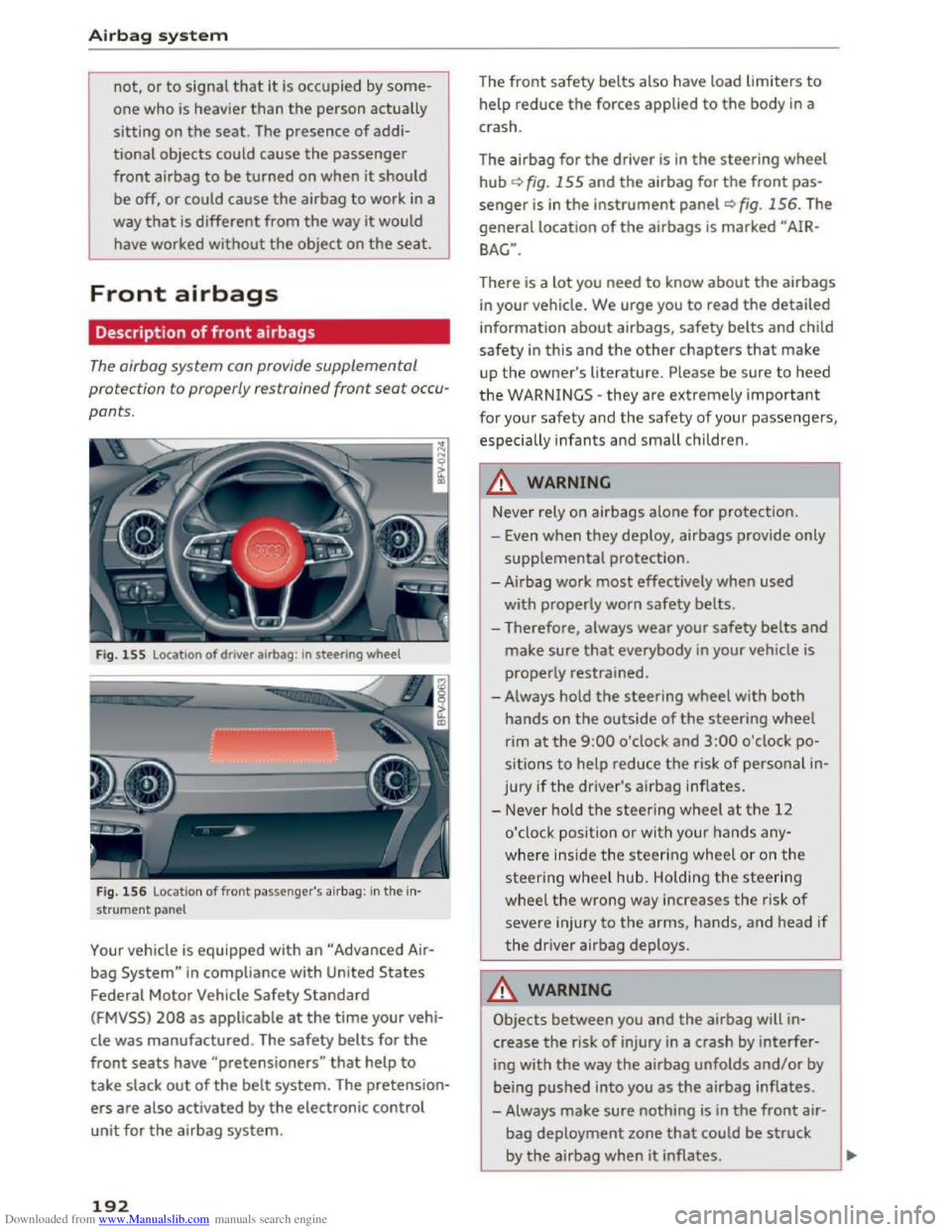
Downloaded from www.Manualslib.com manuals search engine Airbag system
not, or to signal that it is occupied by some
one who is heavier than the person actually
sitting on the seat. The presence of addi
tional objects could cause the passenger
front airbag to be turned on when it should
be off, or could cause the airbag to work in a
way
that is different from the way it would
have worked
without the object on the seat.
Front airbags
Description of front airbags
The airbag system can provide supplemental
protection to properly restrained front
seat occu
pants.
Fig. 155 Locat ion of driver airbag : in steering wheel
Fig.
156 Location of front passenger's airbag: in the in·
strument panel
Your vehicle is equipped with an "Advance d Air
bag System" in compliance with United States
Federal Motor Vehicle Safety Standard
(FMVSS) 208 as applicable at the time your vehi
cle
was manufactured. The safety belts for the
front seats have "pretensioners" that help to
take slack out of the belt system. The pretension
ers are also activated by the electronic control
unit for the airbag system.
192
The front safety belts also have load limiters to
help reduce the forces applied to the body in a
crash.
The airbag
for the driver is in the steering wheel
hub i::> fig. 155 and the airbag for the front pas
senger is in the instrument panel i::> fig. 156. The
general location of the airbags is marked "AIR
BAG".
There is a lot you need to know about the airbags
in your vehicle. We urge you to read the detailed
information about airbags, safety belts and child
safety in this and the other chapters that make
up the owner's literature. Please be sure to heed
the WARNINGS -they are extremely important
for your safety and the safety of your passengers,
especially infants and small children .
_&WARNING
-
Never rely on airbags alone for protection.
- Even when they deploy, airbags provide only
supplemental protection.
-Airbag work most effectively when used
with properly
worn safety belts.
- Therefore, always
wear your safety belts and
make sure that everybody in your vehicle is
properly
restrained.
- Always hold the steering wheel with both
hands on the outside of the steering wheel
rim at the 9:00 o'clock and 3:00 o'clock po
sitions
to help reduce the risk of personal in
jury if the driver's airbag inflates.
-Never hold the steering wheel at the 12
o'clock position or with your hands any
where inside the steering wheel or on the
steering wheel hub. Holding the steering
wheel the wrong way increases the risk of
severe injury to the arms, hands, and head if
the driver airbag deploys.
_&WARNING
Objects between you and the airbag will in
crease the risk of injury in a crash by interfer
ing with the way the airbag unfolds and/or by
being pushed into you as the airbag inflates.
- Always
make sure nothing is in the front air-
bag deployment zone that could be struck
by the airbag when it inflates. _____ ___.
Page 195 of 322
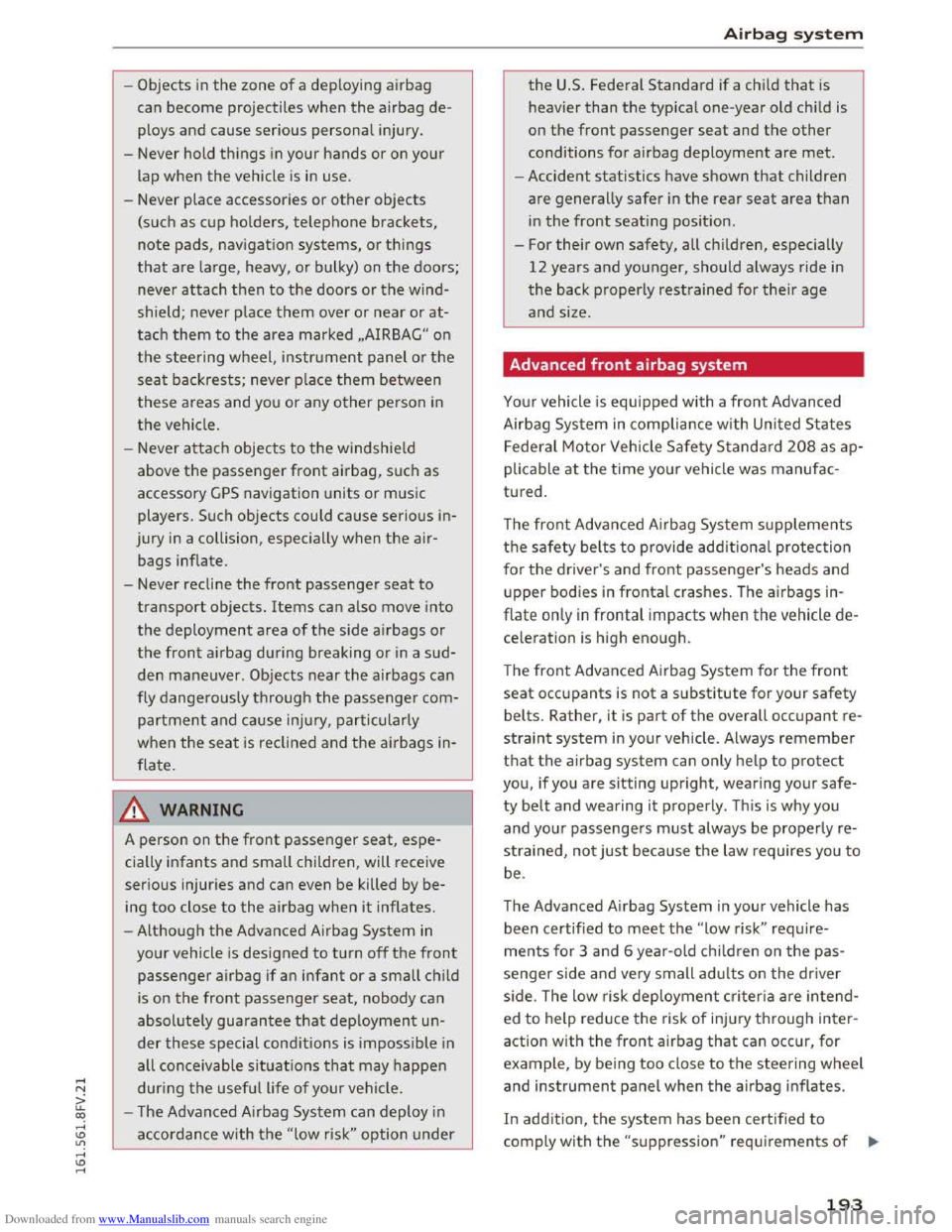
Downloaded from www.Manualslib.com manuals search engine -Objects in the zone of a deploying airbag
can
become projectiles when the airbag de
ploys and cause serious personal injury.
- Never hold
things in your hands or on your
lap
when the vehicle is in use.
-Never place accessories or other objects
(such as cup holders, telephone brackets,
note pads, navigation systems, or things
that are large, heavy, or bulky) on the doors;
never
attach then to the doors or the wind
shield; never place
them over or near or at
tach them to the area marked ,.AIRBAG" on
the steering wheel, instrument panel or the
seat backrests; never place them between
these areas and you or any other person in
the vehicle.
- Never
attach objects to the windshield
above
the passenger front airbag, such as
accessory GPS navigation units or music
players. Such
objects could cause serious in
jury
in a collision, especially when the air
bags inflate.
- Never recline
the front passenger seat to
transport objects. Items can also move into
the deployment area of the side airbags or
the front airbag during breaking or in a sud
den maneuver. Objects near the airbags can
fly dangerously through the passenger com
partment and cause injury, particularly
when the seat is reclined and the airbags in
flate.
A WARNING
A person on the front passenger seat, espe
cially infants and small children, will receive
serious injuries and can even be killed by be
ing
too close to the airbag when it inflates.
- Although
the Advanced Airbag System in
your vehicle is designed to turn off the front
passenger airbag if an infant or a small child
is on
the front passenger seat, nobody can
absolutely guarantee that deployment un
der these special conditions is impossible in
all conceivable situations that may happen
during the useful life of your vehicle.
- The Advanced Airbag
System can deploy in
accordance with the "low risk" option under
-I
Airbag system
the U.S. Federal Standard if a child that is
heavier
than the typical one-year old child is
on
the front passenger seat and the other
conditions for airbag deployment are met.
- Accident statistics have shown that children
are generally safer in the rear seat area than
in the front seating position .
- For
their own safety, all children, especially
12 years and younger, should always ride in
the back properly restrained for their age
and size.
Advanced front airbag system
Your vehicle is equipped with a front Advanced
Airbag
System in compliance with United States
Federal Motor Vehicle Safety Standard 208 asap
plicable at the time your vehicle was manufac
tured.
The front Advanced Airbag System supplements
the safety belts to provide additional protection
for the driver's and front passenger's heads and
upper bodies in frontal crashes. The airbags in
flate only in frontal impacts when the vehicle de
celeration is high enough.
The front Advanced Airbag System for the front
seat occupants is not a substitute for your safety
belts. Rather, it is part of the overall occupant re
straint system in your vehicle. Always remember
that the airbag system can only help to protect
you, if you are sitting upright, wearing your safe
ty belt and wearing it properly. This is why you
and your passengers must always be properly re
strained, not just because the law requires you to
be.
The Advanced Airbag
System in your vehicle has
been certified to meet the "low risk" require-
ments for 3 and 6 year-old children on the pas
senger side and very small adults on the driver
side. The low risk
deployment criteria are intend
ed to help reduce the risk of injury through inter
action with the front airbag that can occur, for
example, by being too close to the steering wheel
and instrument panel when the airbag inflates.
In addition,
the system has been certified to
comply with the "suppression" requirements of .,..
193
Page 196 of 322
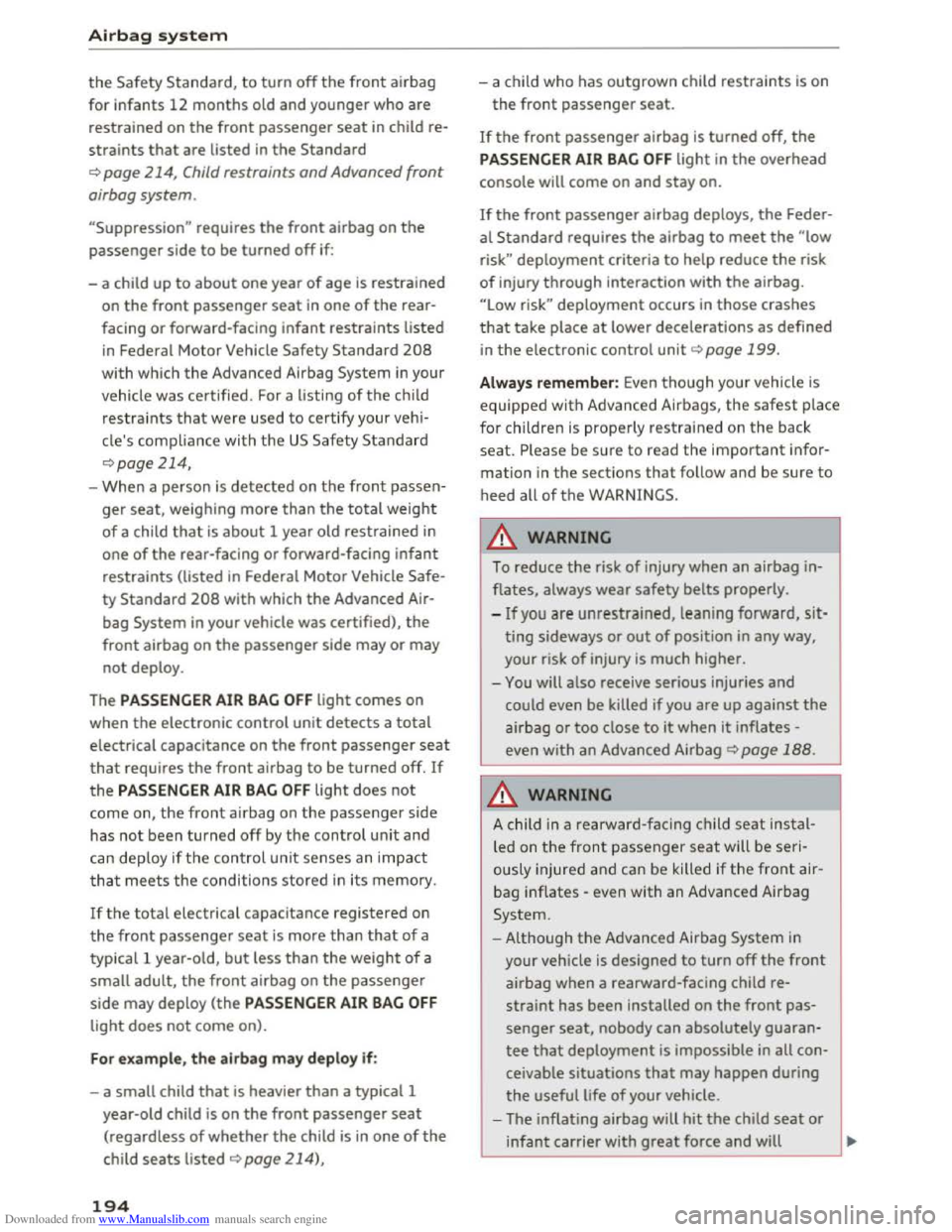
Downloaded from www.Manualslib.com manuals search engine Airbag sy ste m
the Safety Standard, to turn off the front airbag
for infants 12 months old and younger who are
restrained on the front passenger seat in child re
straints that are listed in the Standard
¢ page 214, Child restraints and Advanced front
airbag system.
"Suppression" requires the front airbag on the
passenger side to be turned off if:
- a child up
to about one year of age is restrained
on the front passenger seat in one of the rear
facing
or forward-facing infant restraints listed
in Federal Motor Vehicle Safety Standard 208
with which the Advanced Airbag System in your
vehicle was certified. For a listing of the chi ld
r
estraints that were used to certify your vehi
cle's
compliance with the US Safety Standard
C)page 214,
-When a person is detected on the front passen
ger seat, weighing more than the total weight
of a child that is about 1 year old restrained in
one of the rear-facing or forward-facing infant
restraints (listed in Federal Motor Vehicle Safe
ty Standard 208 with which the Advanced Air
bag System in your vehicle was certified), the
front airbag on the passenger side may or may
not deploy.
The
PASSEN GER AIR BAG OFF light comes on
when the electronic control unit detects a total
electrical capacitance on the front passenger seat
that requires the front airbag to be turned off. If
the PASSENGER AIR BAG OFF light does not
come on, the front airbag on the passenger side
has not been turned off by the control un it and
can depl oy ifthe control unit senses an impact
that meets the conditions stored i n its memory.
If the total electrical capacitance registered on
the front passenger seat is more than that of a
typical 1 year-old,
but less than the weight of a
small adult, the front airbag on the passenger
side may deploy (the PASSENGER AIR BAG OFF
light does not come on).
For example, the airb ag may dep lo y if:
- a small child that is heavier than a typical 1
year-old child is
on the front passenger seat
(regardless of whether the child is in one of the
child seats listed ~page 214),
194
-a child who has outgrown child restraints is on
the front passenger seat.
If the front passenger airbag is turned off, the
PASSENGER AIR BAG OFF light in the overhead
console will come on and stay on.
If the front passenger airbag deploys, the Feder
al Standard requires the airbag to meet the "low
risk"
deployment criteria to help reduce the risk
of injury through interaction with the airbag.
"Low risk" deployment occurs in those crashes
that take place at lower decelerations as defined
in the electronic control unit ¢page 199.
Always remember: Even though your vehicle is
equipped with Advanced Airbags, the safest place
fo r childre n is properly restrained on the back
seat. Please be sure to read the important infor
mation in the sections that follow and be sure to
heed all of the WARNINGS.
A WARNING
To reduce the risk of injury when an airbag in
flates, always wear safety belts properly.
-
If you are unrestrained, leaning forward, sit·
ting sideways or out of position in any way,
your risk of injury is much higher.
- You will
also receive serious injuries and
could even be killed if you are up against the
airbag or too close to it when it inflates -
even
with an Advanced Airbag~ page 188.
A WARNING
A child in a rearward-facing child seat instal
led on the front passenger seat will be seri
ously injured and can be killed if the front air
bag inflates· even with an Advanced Airbag
System.
-Although the Advanced Airbag System in
your vehicle is designed to turn off the front
airbag when a rearward-facing child re
straint has been installed on the front pas
senger seat, nobody can absolutely guaran
tee that deployment is impossible in all con
ceivable situations that may happen during
the useful life of your vehicle.
- T
he inflating airbag will hit the child seat or
-
infant carrier with great force and will ~
Page 197 of 322
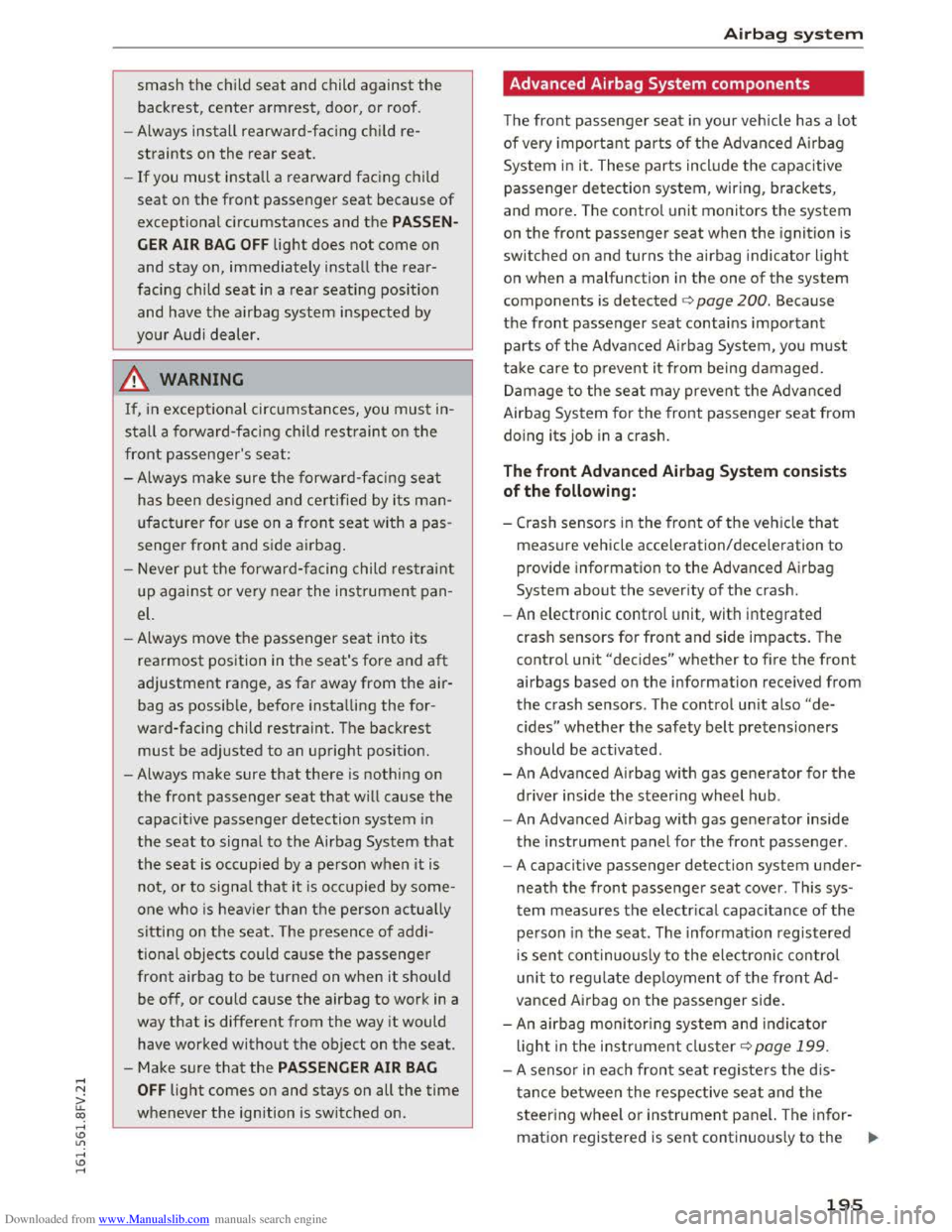
Downloaded from www.Manualslib.com manuals search engine smash the child seat and child against the
backrest, center armrest, door, or roof.
- Always
install rearward-facing child re
straints on the rear seat.
-If you must install a rearward facing child
seat on the front passenger seat because of
exceptional circumstances and the PASSEN
GER AIR BAG OFF light does not come on
and stay on, immediately install the rear
facing child
seat in a rear seating position
and have the airbag system inspected by
your Audi dealer.
A WARNING
If, in exceptional circumstances, you must in
stall a forward-fac ing chi ld restraint on the
front passenger's seat:
- Always make sure the forward-fac ing seat
has been designed and cer t ified by its man
ufacturer for use on a fron t seat with a pas
senger front and side airbag .
- Never
put the forward-facing child restraint
up against or very near the instrument pan
el.
-Always move the passenger seat into its
rearmost position in the seat's fore and aft
adjustment range, as far away from the air
bag as possible, before install ing the for
ward-facing child
restraint. The backrest
must be adjusted to an upright positio n.
-Always make sure that there is nothing on
the front passenger seat that will cause the
capacitive passenger detection system in
the seat to signa l to the Airbag System that
the seat is occupied by a person when it is
not, or to signa l that it is occupied by some
one who is heavier than the person actually
sitting on the seat. T he presence of addi
tional objec ts could cause the passenger
fro nt airbag to be turned on when it should
be off, or could cause the airbag to work in a
way
that is different from the way it would
have worked
without the object on the seat.
- Make
sure that the PASSENGER AIR BAG
OFF light comes on and stays on all the time
whenever the ignition is switched on.
Airbag system
Advanced Airbag System components
The front passenger seat in your vehicle has a lo t
of ve ry important parts of the Advan ced Airb ag
System in it. These parts include the capacitive
passenger detection system, wiring, brackets,
and more. The control unit monitors the system
on the front passenger seat when the ignition is
switched on and turns the airbag indicator light
on when a malfunction in the one of the system
components is detected c> page 200. Because
the front passenger seat contai ns important
parts of the Advanced Airbag System, you must
take care to p revent it from being damaged.
Dam age to the seat m ay prevent the Advan ced
Airbag
System for the front passenger seat from
doing its job in a crash.
The front Advanced Airbag System consists
of the following:
-Crash sensors in the front of the ve hicl e tha t
measure vehicle acceleration/deceleration to
prov ide information to the Advanced Airbag
System about the severity of the crash.
-
An electronic control unit, with integrated
crash sensors for front and side impacts. The
control un it "decides" whether to f ir e the front
airbags based on the information rece ived from
the crash sensors. The control unit also "de
cides" whether the safety belt pretensioners
should be activated.
-
An Advanced Airbag with gas generator for the
driver inside the steering wheel hub .
-
An Adva nced Airbag with gas generator inside
the instrument panel for the front passenger.
- A
capacitive passenger detection system under
neath the front passenger seat cove r. This sys
tem measures the electrica l capacitance of the
pe rson in the seat. The information registered
is sent continuous ly to the electronic control
u
nit to reg ulate deployment of t he front Ad
vanced Airbag on
the passenger side.
-
An airbag monitori ng system and ind ic a tor
ligh t in t he i nstrument cl us ter c>poge 199.
-A sensor in each front seat registers t he d is
tance between the respective seat and the
steering wheel or ins trument panel. The infor-
mation registered is sent continuousl y to the ...
195
Page 198 of 322

Downloaded from www.Manualslib.com manuals search engine Airbag system
electronic control unit to regula te deployment
of the front Advanced Airbags.
- The
PASSENGER AIR BAG OFF light comes on
and stays on in the overhead console
¢page 200, fig. 158 and tells you when the
front Advanced Airbag on the passenger side
has
been turned off.
- A
sensor in the safety belt latch for the driver
and for
the front seat passenger that senses
whether that safety belt is latched or not and
transmits this information to the electronic
control unit.
A WARNING
Damage to the front passenger seat can pre
vent the front airbag from working properly.
-
Improper repai r or disassembly of the front
passenger and drive r seat will prevent the
Advanced Airbag System from functioning
properly.
-Repairs to the front passenger seat must be
performed by qualified and properly trained
workshop personnel.
-Never remove the front passenger or driver
seat from the vehicle.
- Never remove
the upholstery from the front
passenger seat.
-Never disassemble or remove parts from the
seat or disconnect wires from it.
- Never carry
sharp objects in your pockets or
put them on the seat. The capacitive pas
senger detection mat in the front p assenger
seat will not function properly if it is punc
tur ed.
- Never carry
things on your lap or carry ob
jects on the front passenger seat. Such ob
jects can influence the capacitance regis
tered by the capacitive passenger detection
system, so that incorrect information is pro
vided to the airbag control unit.
- Never
store items under the front passenger
seat. Parts of the Advanced Airbag System
under the passenger seat could be dam
aged, preventing them and the airbag sys
tem from working properly.
- Never place
seat covers or rep lacement up
holstery that have not been specifically ap
proved by Audi on the front seats.
196
-Seat covers can prevent the Advanced Air
bag System from recognizing child re
straints or occupants on the front passenger
seat and prevent the side airbag in the seat
backrest from deploying properly.
-If a seat heater has been retrofitted or oth
erwise added to the front passenger seat,
never install any child restraint system on
this seat.
-Never use cushions, pill ows , blankets, or
simila r items on the front passenger seat.
The additional laye rs p revent the capacit ive
p a
ssenger detecti on sys tem from accurately
measuring the capacitan ce of the child safe
ty seat and/or the person on the seat and
thus keep the Advanced Airbag System from
working properly.
- Never pl
ace or use any electrica l device
(such as a
laptop, CD player, electronic
games device, power inverter or seat heater
for child seats) on the front passenger seat
if the device is connected to the 12-volt
socket or the cigarette lighter socket. Such
dev i
ces can influence the capac itance regis
tered by the capacitive passenger detection
system, so that incorrect information is pro
vided to the airb ag control unit.
- I f you
must use a child restraint on th e fron t
p a
ssenger seat a nd the child restrain t man
ufacturer's instructions require the use of a
towel,
foam c u shion or something else to
properly position the child restraint, make
certain that the PASSENGER AIR BAG OFF
light comes on and stays on whenever the
child restraint is installed on the front pas
senger seat.
-
If the PASSENGER AIR BAG OFF light does
not come on and stay on, immediately in
stall child restraint in a rea r seating pos ition
and have
the airbag system inspected by
your Audi dea le r.
A WARNING
If the front passenger seat gets wet, dry it im-
mediately.
..,,.
Page 199 of 322
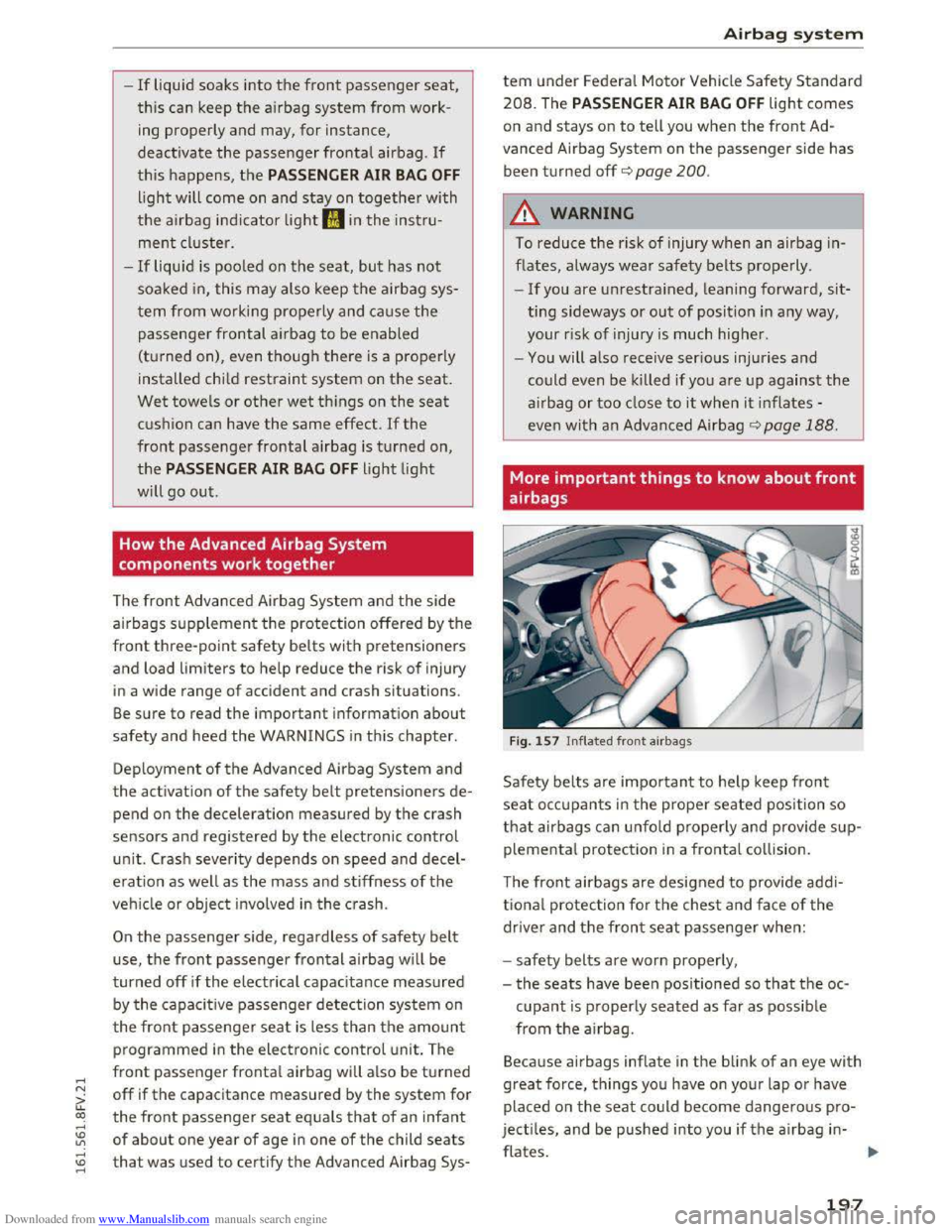
Downloaded from www.Manualslib.com manuals search engine ..... N
G: CX)
.....
"' U"I
.....
"' .....
-If liquid soaks into the front passenger seat,
this can keep the airbag system from work
ing properly
and may, for instance,
deactivate
the passenger frontal airbag . If
this happens, the PASSENGER AIR BAG OFF
light will come on and stay on together with
the airbag indicator light fl in the instru
ment cluster.
-
If liquid is pooled on the seat, but has not
soaked in, this may also keep the airbag sys
tem from working properly and cause the
passenger frontal airbag to be enabled
(turned on), even though there is a properly
installed child
restraint system on the seat.
Wet towels or other wet things on the seat
cushion can have the same effect. If the
front passenger frontal airbag is turned on,
the PASSENGER AIR BAG OFF light light
will go
out.
How the Advanced Airbag System
components work together
The front Advanced Airbag System and the side
airbags supplement the protection offered by the
front three-point safety belts with pretensioners
and load limiters to help reduce the risk of injury
in a wide range of accident and crash situations.
Be sure to read the important information about
safety and heed the WARNINGS in this chapter.
Deployment
of the Advanced Airbag System and
the activation of the safety belt pretensioners de
pend on the deceleration measured by the crash
sensors and registered by the electronic control
unit. Crash severity depends on speed and decel
eration as well as the mass and stiffness of the
vehicle or object involved in the crash.
On the passenger side, regardless of safety belt
use, the front passenger frontal airbag will be
turned off ifthe electrical capacitance measured
by the capacitive passenger detection system on
the front passenger seat is less than the amount
programmed in the electronic control unit. The
front passenger frontal airbag will also be turned
off if the capacitance measured by the system for
the front passenger seat equals that of an infant
of about one year of age in one of the child seats
that was used to certify the Advanced Airbag Sys-
Airbag system
tern under Federal Motor Vehicle Safety Standard
208. The PASSENGER AIR BAG OFF light comes
on and stays on to tell you when the front Ad
vanced Airbag System on
the passenger side has
been turned off c::;, page 200.
A WARNING
f-=
To reduce the risk of injury when an airbag in-
flates, always wear safety belts properly.
-
If you are unrestrained, leaning forward, sit
ting sideways
or out of position in any way,
your risk
of injury is much higher .
-
You will also receive serious injuries and
could even be killed if you are up against the
airbag or too close to it when it inflates -
even with an Advanced Airbag ¢page 188.
More important things to know about front
airbags
Fig. 157 Inflated front airbags
Safety belts are important to help keep front
seat occupants in the proper seated position so
that airbags can unfold properly and provide sup
plemental protection in a frontal collision.
The
front airbags are designed to provide addi
tional protection for the chest and face of the
driver and the front seat passenger when:
-
safety belts are worn properly,
-
the seats have been positioned so that the oc-
cupant is properly seated as far as possible
from the airbag .
Because
airbags inflate in the blink of an eye with
great force, things you have on your lap or have
placed on
the seat could become dangerous pro
jectiles, and
be pushed into you ifthe airbag in-
flates. .,..
197
Page 200 of 322
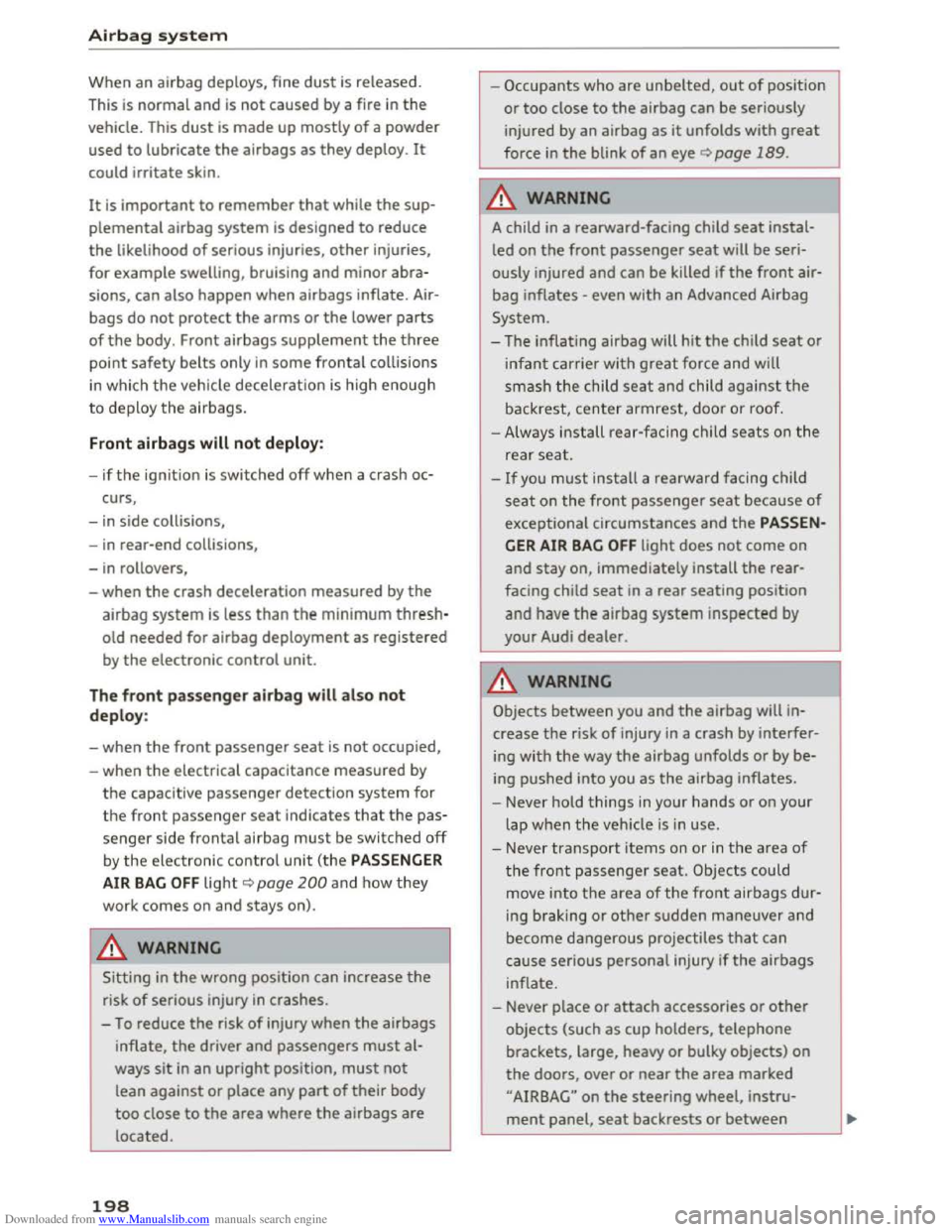
Downloaded from www.Manualslib.com manuals search engine Airbag sy ste m
When an airbag deploys, fine dust is released.
This is normal and is not caused by a fire in the
vehicle. This dust is made up mostly of a powder
used to lubricate the airbags as they deploy. It
could irritate skin.
It is important to remember that while the sup
plemental airbag system is designed to reduce
the likelihood of serious injuries, other injuries,
for example swelling , bruising and minor abra
sions, can also happen when airbags inflate. Air
bags do not protect the arms or the lower parts
of the body. Front airbags supplement the three
point safety belts only in some frontal collisions
in which the vehicle deceleration is high enough
to deploy the airbags.
Front airbag s will not deploy:
-ifthe ignit ion is switched off when a crash oc-
curs,
-in side collisions,
-
in rear-end collisions,
-
in rollovers,
-
when the crash deceleration measured by the
airbag system is less than the minimum thresh
old needed for airbag deployment as registered
by the electronic control unit.
The front passenge r airbag will also not
deploy:
-when the front passenger seat is not occupied,
-
when the electrical capacitance measured by
the capacitive passenger detection system for
the front passenger seat indicates that the pas
senger side frontal airbag must be switc hed off
by the electronic control unit (the PASSENGER
AIR
BAG OFF light Q page 200 and how they
work comes on and stays on).
A WARNING
Sitting in the wrong position can increase the
risk of serious injury in crashes.
-To reduce the risk of injury when the airbags
inflate, the driver and passengers must al
ways
sit in an upright position, must not
lean against or place any part of their body
too close to the area where the airbags are
located.
198
-Occupants who are unbelted, out of position
or too close to the airbag can be seriously
injured
by an airbag as it unfolds with great
force in the blink of an eye Q page 189.
A WARNING
A child in a rearward-facing child seat instal
led
on the front passenger seat will be seri
ously injured
and can be killed if the front air
bag inflates -even with an Advanced Airbag
System.
-The inflating airbag will hit the child seat or
infant carrier with great force and will
smash the child seat and child against the
backrest, center armrest, door or roof.
- Always install rear-facing
child seats on the
rear seat.
- If you must install a rearward facing child
seat on the front passenger seat because of
exceptional circumstances and the PASSEN
GER AIR BAG OFF light does not come on
and stay on, immediately install the rear
facing child seat in a rear seating position
and have the airbag system inspected by
your Audi dealer.
A WARNING
Objects between you and the airbag will in
crease the risk of injury in a crash by interfer
ing with the way the airbag unfolds or by be
ing pushed into you as the airbag inflates.
- Never hold
things in your hands or on your
lap when the vehicle is in use.
-
-Never transport items on or in the area of
the front passenger seat. Objects could
move in
to the area of the front airbags dur
ing braking or other sudden maneuver and
become dangerous projectiles that can
cause serious personal injury if the airbags
inflate.
- Never place
or attach accessories or other
objects (such as cup holders, telephone
brackets, large, heavy or bulky objects) on
the doors, over or near the area marked
"AIRBAG" on the steering wheel, instru
ment panel, seat backrests or between